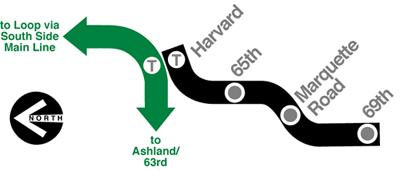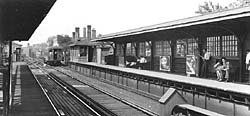Chicago ''L''.org: Operations - Lines - (original) (raw)
| 
 | |
| ------------------------------------------------------------------------------------------------- | |
| |
| ------------------------------------------------------------------------------------------------- | |
 |
 |
|---|
Normal Park branch
 |
|---|
Legend:  Demolished Line w/Former Station Demolished Line w/Former Station  Current Line w/Former Transfer Station Click on a station name to see that station's profile (where available) Current Line w/Former Transfer Station Click on a station name to see that station's profile (where available) |
Service Notes:
Date of Opening: 1907 Date of Abandonment: 1954 Length of Route: 0.85 miles (approx.) Number of Stations: 4 stations
History:
When the South Side Rapid Transit was awarded a franchise for an extension from 39th Street to Jackson Park in the early 1890s, two branches were also approved. One was to leave the line between 55th and 59th Street and head in a generally easterly direction, terminating south of 63rd Street between Wentworth and Wallace. With the South Side Elevated's successful outlook in the early 1900s, they decided to exercise this clause and construct their first branch.

A two-car train of4000s approaches the 69th Street, station at the end of the Normal Park branch. He has switched over from the inbound track at the crossover just north of the station to berth at the east platform. For a larger view, click here.(Photo from the Charles E. Keevil/Walter R. Keevil Collection)
The Englewood Elevated Railroad Company was incorporated in early 1903 to construct the branch and on March 16th, they were granted a franchise to build a main line (the Englewood branch) and a short branch (the Normal Park branch). The ordinance outlined a route basically the same as the original clause in the 1890s franchise, but extended the main line from between Wallace and Wentworth westward between 60th and 67th streets to a terminal between Center (Racine) and Ashland avenues. The Normal Park branch was to leave the main line near Wentworth and continue south to between 68th and 72nd streets.
The short Normal Park branch, less than a mile long, opened on May 25, 1907. The branch departed from the Englewoodbranch west of Harvardstation at Stewart Junction and proceeded southward to 69th Street, with a small westward S-curve south of 67th Street. The line ran on private right-of-way next to public alleys. There were lightly-used intermediate stations at 65th and 67th Streets that depended largely on walk-in traffic, and a stub-end terminal at 69th Street. All three stations had street-level brick station houses with copper and wood trim, stone sills and limestone column bases executed in the Greek Revival style. The articulated cornice, triglyphs and pilasters resembled a Doric temple. They were similar to stations at Racine andHalsted on the Englewoodbranch and 42nd Placeterminal on the Kenwood branch designed by architect Earl Nielson, indicating he may also be responsible for these structures. The stations, including the terminal, had dual side platforms with wood floors, steel railings and peaked canopies with tin roofs and latticework along the back near the roofline. Interestingly, even though only single car -- sometimes two in weekday rush -- were operated, station platforms were a full 8 car lengths by the time of the branch's later years. Reportedly, at69th station, only the east platform was typically used for loading and unloading, with the other track for lay-ups. There was a tower at the north end of the east platform at one point, but it is questionable how often it was manned, especially in later years. Later, there were just two crossovers, with one being equipped with a spring switch. Apart from a small commercial district on 69th Street and a moderate density residential neighborhood, the only major traffic generator for the line was the Chicago Normal School teacher's college located near the terminal.
From 1907 to 1949, Normal Park cars were coupled to and from Englewood trains at Harvardstation for the trip north and to return to the branch. This practice continued even after crosstown service began in 1913 and Englewood/Normal Park trains were through-routed to Wilson. On February 23, 1931, the CRT revamped crosstown service. Englewood/Normal Park trains were routed to the Ravenswoodduring rush hour and terminated in the Loop during off-peak times. Upon its opening in 1943, these trains were through-routed at all times via the State Street Subway.
Decline
Because of the Normal Park branch's very moderate catchment area from which to attract riders, when the system began sliding into decline during the Depression the branch became a quick target for economizing. Between 1931 and 1937, conductors began collecting fares during some off-peak times, eliminating the need for station agents. (With the exception of the 69th Street terminal, it's probably questionable whether any of the stations really ever needed an agent...)
By the time the CTA took over in October 1947, the Normal Park was still just a little branch with no real future or potential for expansion. On August 1, 1949, the CTA initiated their North-South service revision and turned the Normal Park branch into a shuttle operation. Once it was made a shuttle, its fate was sealed. A single train of one or two wood cars usually worked the branch back and forth between 69th andHarvard stations. Transferring to Normal Park trains at Harvardrequired going down from the outbound platform to the mezzanine and back up the other side, as Normal Park trains loaded and unloaded from the inbound platform. A crossover where southbound Normal Park trains could switch over from the inbound track to the outbound track was location between Steward Junction and Harvard. Another strike against the branch's future was that it necessitated keeping the Stewart Junction tower manned three shifts. It was only a matter of time before CTA eliminated the poorly-performing service.
All three little-used stations on the branch -- the traffic of the two intermediate stations at 65th and Marquette (67th) combined was usually less than that of the 69thterminal, which itself was hardly a crush-load station -- had their agents eliminated in 1949. Afterward, conductors collected fares at all times on the branch, except at the Harvard transfer point. The intermediate stations at 65th and Marquette were more or less gutted at some point afterward and left as empty shells. Because of the need to secure 69th Street station at night due to the cars stored on the stub tracks above, the station was heavily modified. Most of the doors were permanently bolted shut and the others had switch locks put on them. One door was left for access. It was originally an exit door, but instead of installing a handle on the outside so that it could also function as an entrance, a nail was hammered into the top of the door so it couldn't close all the way and passengers had to slip their fingers in the crack and pull the door open. Not very inviting!
As can be imagined, ridership continued to decline. Soon after the branch was converted into a shuttle, late evening and owl service was discontinued on January 1, 1950. On May 18, 1952, weekend, holiday, and midday service was eliminated, reducing the branch to running during weekday rush hours only. By late 1953, the branch was generating only about 100 fares a day, hardly enough to justify a bus line let alone a rapid transit service. Finally, on January 29, 1954, service on the Normal Park branch was suspended and the line closed. No replacement service was provided, though it was hardly needed. By summer 1954, the branch was being dismantled.
Although there are few if any remnants of the branch -- all of the stations are gone and a Chicago Public Schools building has been built on the former right-of-way immediately south of Stewart Junction -- the CTA still owns a few small sections of the right-of-way to this day. To some degree, the Dan Ryan Line, opened in 1969 and located approximately a half mile east of the former branch, serves the same area as the Normal Park branch had, including a station at 69th Street.
 |
 |
|---|